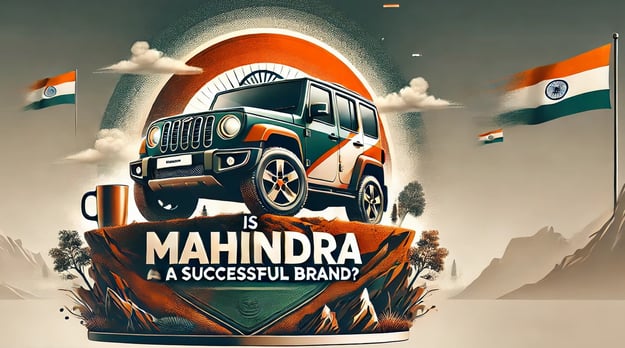Is Mahindra a Successful Brand? Exploring the Journey of an Indian Giant
When I was a child, my dad had a Mahindra Jeep. It wasn’t fancy, but it was solid, reliable, and could tackle rough roads with ease. I remember bouncing around in the backseat during road trips to my grandparents’ village, feeling like an adventurer on an epic quest. This rugged Jeep was my first introduction to Mahindra, a name that’s synonymous with durability and innovation in India. But as I grew older and explored more about brands and businesses, I started wondering: is Mahindra truly a successful brand? In my opinion, the answer is a resounding yes, and here’s why.
Laksh Rathore
12/1/20244 min read


Is Mahindra a successful Brand? Exploring the Journey of an Indian Giant
When I was a child, my dad had a Mahindra Jeep. It wasn’t fancy, but it was solid, reliable, and could tackle rough roads with ease. I remember bouncing around in the backseat during road trips to my grandparents’ village, feeling like an adventurer on an epic quest. This rugged Jeep was my first introduction to Mahindra, a name that’s synonymous with durability and innovation in India. But as I grew older and explored more about brands and businesses, I started wondering: is Mahindra truly a successful brand? In my opinion, the answer is a resounding yes, and here’s why.
The Legacy of Reliability and Innovation
Mahindra’s journey began in 1945, when it was founded as a steel trading company. By 1947, it was assembling Willys Jeeps in India. This wasn’t just a business decision; it was a statement of intent. At a time when India was newly independent and seeking self-reliance, Mahindra’s rugged vehicles became a symbol of strength and capability.
What I’ve learned is that Mahindra has always been about creating products that meet the needs of the Indian consumer. Whether it’s tractors for farmers or SUVs for families, the brand has consistently delivered. According to data from the Society of Indian Automobile Manufacturers (SIAM), Mahindra is one of the largest manufacturers of tractors and utility vehicles in India. This dual focus on agriculture and automotive sectors has been a cornerstone of its success.
From my own experience, Mahindra’s vehicles are built to last. My dad’s Jeep, for example, was used for over a decade before we finally sold it, and even then, it ran perfectly. This focus on durability has earned Mahindra a loyal customer base, especially in rural and semi-urban areas where reliability is non-negotiable.
The SUV King of India
When you think of SUVs in India, Mahindra is probably one of the first names that comes to mind. Models like the Scorpio, Bolero, and XUV500 have become icons in their own right. The Bolero, for instance, is a best-seller in rural markets due to its robustness and ease of maintenance. On the other hand, the Scorpio, with its bold design and powerful performance, appeals to urban and semi-urban audiences alike.
In my opinion, Mahindra’s ability to read the market and adapt is key to its success. Take the launch of the XUV700 in 2021, for example. It was packed with features like ADAS (Advanced Driver Assistance Systems), a panoramic sunroof, and connected car technology, all at a competitive price point. According to Autocar India, the XUV700 received over 50,000 bookings within the first two months of its launch, proving that Mahindra knows how to capture the pulse of the market.
Another aspect that stands out is Mahindra’s foray into electric vehicles (EVs). With the launch of the e-Verito and plans to introduce more EVs in the future, the company is positioning itself as a player in the sustainable mobility space. While it’s still early days, I think this move reflects Mahindra’s forward-thinking approach and commitment to staying relevant in a rapidly changing industry.
Beyond Automobiles: A Diversified Powerhouse
What I’ve found fascinating about Mahindra is that it’s not just an automobile company. The brand operates in over 100 countries and has interests in sectors as diverse as agriculture, IT, real estate, and even hospitality. Mahindra Tractors, for example, is the world’s largest tractor manufacturer by volume, serving millions of farmers globally.
One of the most intriguing aspects of Mahindra’s diversification is its focus on social impact. Through initiatives like Mahindra Rise, the company aims to drive positive change in areas like education, healthcare, and rural development. In my opinion, this focus on giving back to society enhances the brand’s reputation and makes it more relatable to the average Indian.
Even in the lifestyle segment, Mahindra has made its mark. The Thar, for example, is not just a car; it’s a lifestyle statement. I’ve seen so many of my friends dream of owning a Thar for weekend getaways and off-road adventures. This ability to evoke aspirations while meeting functional needs is a testament to Mahindra’s branding prowess.
Challenges and Opportunities
Of course, no brand is without its challenges. Mahindra faces stiff competition from global giants like Toyota and Hyundai, as well as homegrown brands like Tata Motors. Additionally, the transition to EVs and the need for more sustainable practices present hurdles that require significant investment and innovation.
What I’ve observed, though, is that Mahindra has a knack for turning challenges into opportunities. For instance, its focus on rural markets has helped it weather economic slowdowns better than some of its competitors. Moreover, its investments in technology and R&D suggest that the brand is well-prepared for the future.
Final Thoughts
So, is Mahindra a successful brand? In my opinion, the answer lies in its ability to adapt, innovate, and connect with its audience. Whether it’s building reliable tractors for farmers, rugged SUVs for adventure seekers, or eco-friendly EVs for the future, Mahindra has consistently delivered value. Reflecting on my own experiences and observations, I think Mahindra represents the spirit of India: resilient, innovative, and forward-looking. It’s a brand that has grown with the country, shaping and being shaped by the needs and aspirations of its people.
